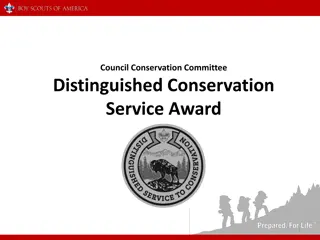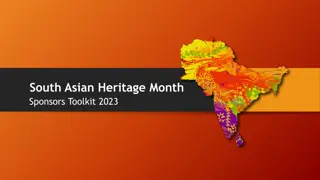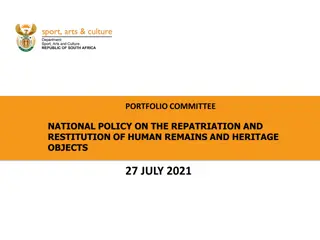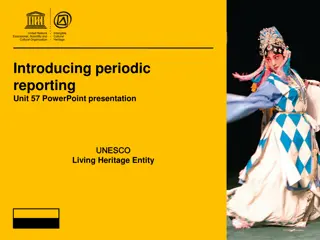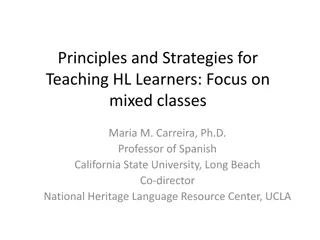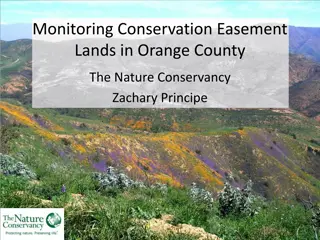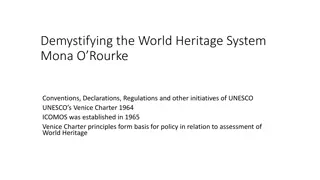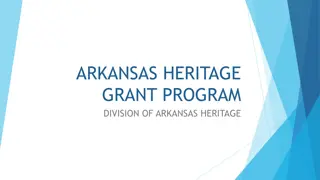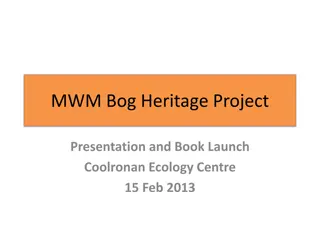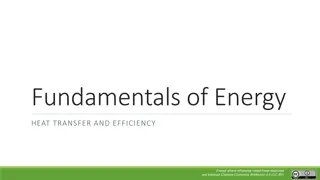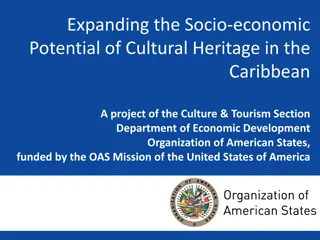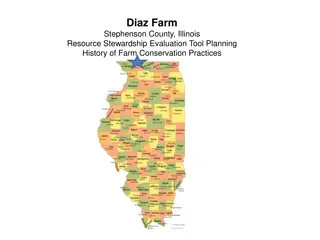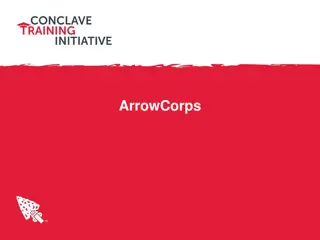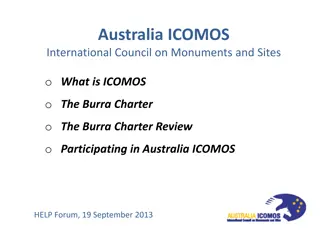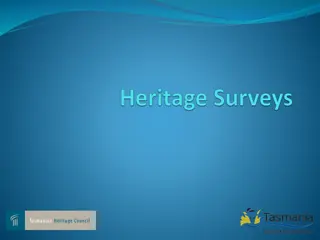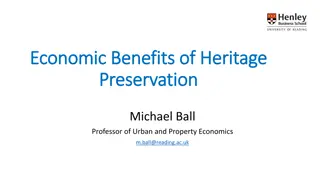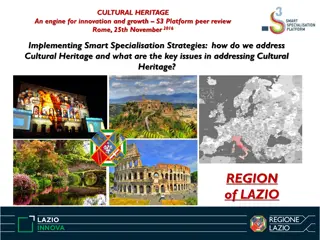Exploring Geotourism: Heritage Conservation and Economic Opportunities
Geotourism combines natural and cultural heritage to drive economic development, focusing on post-mining communities. It celebrates geodiversity, biodiversity, and human diversity, offering a holistic tourism experience that is gaining global popularity. This approach incorporates various nature-based tourism types and emphasizes place-based experiences, distinguishing itself from traditional geological tourism.
Uploaded on Oct 10, 2024 | 0 Views
Download Presentation

Please find below an Image/Link to download the presentation.
The content on the website is provided AS IS for your information and personal use only. It may not be sold, licensed, or shared on other websites without obtaining consent from the author. Download presentation by click this link. If you encounter any issues during the download, it is possible that the publisher has removed the file from their server.
E N D
Presentation Transcript
Geotourism - Conserving Heritage and Generating Post-Mining Economies for Communities 17thNovember 2021 Angus M Robinson FAusIMM (CP), Coordinator National Geotourism Strategy, Australian Geoscience Council
Understanding ecotourism & geotourism A GeoRegion: Socio-economic benefits of geotourism The National Geotourism Strategy Goal 5 focusing on mining communities Opportunities for the mining industry, e.g., in the Hunter Valley of NSW Overseas exemplars Take-Aways Today s Agenda
Ecotourism is practised predominantly in protected areas such as national parks whereas geotourism is undertaken also in all areas where primary industry activities are being carried out, whereas Geotourism is increasingly seen globally as an instrument of regional economic development. Ecotourism & Geotourism Concepts
comprises the following features of both natural and cultural heritage: Abiotic non-living aspects such as the sky, climate & geology, landscape and landforms: celebrating GEODIVERSITY. Geotourism Place based and Holistic Biotic the living parts e.g., flora (plants) and fauna (animals): celebrating BIODIVERSITY. Cultural past & present, both Aboriginal and post European settlement (incl. mining), non- living and built: celebrating HUMAN DIVERSITY. Holistic in scope, geotourism is booming globally and a key driver for tourism, particularly in Europe and Asia.
Place Based Geotourism incorporating all types of nature-based tourism Geotourism is experiential tourism Astrotourism Cultural Tourism Cuisine ECOTOURISM Heritage Tourism Agritourism Indigenous Tourism
Fundamentals of Geotourism Geotourism is not 'geological tourism Geotourism is rather place based
An area defined by a proponent (which might include for example a LGA or a RDA) having completed an approved tourism Destination Management Plan (DMP). Defining a GeoRegion - the first step in evaluating the potential of a Geopark. And the proponent now wishes to seek agreement from the State/Territory Geological Survey to designate a defined area of particular natural and cultural heritage which highlights outstanding geoheritage features. i.e., a GeoRegion
By celebrating the geological heritage of an identified GeoRegion, and in connection with all other aspects of the area s natural and cultural heritage (and most significantly, Aboriginal heritage), geotourism enhances awareness and understanding of key issues facing society. Geotourism gives local people a sense of pride and strengthens their identification with a GeoRegion. Societal Benefits of Developing a GeoRegion for Geotourism
A mechanism for celebrating and raising awareness of mining heritage, past & present. An opportunity to enhance community engagement and build social value through ESG considerations i.e., social licence . By celebrating an area s natural and cultural heritage (and most significantly, Aboriginal heritage), geotourism also enhances the understanding of what mining heritage is worth conserving and presenting as a significant contribution to regional economic development and as adaptive re-use of mining landscapes. Societal Benefits of Geotourism for Mining Communities
AGC National Geotourism Strategy Principles United national voice for geotourism development. Working closely with government agencies at all levels to gain their support and endorsement. Reaching out to other natural and cultural heritage specialists. Engaging with local communities.
1. Consideration and promotion of new digital technologies e.g., 3D visualisation, AR & VR etc. 2. To define an approval pathway for major geotourism projects. 3. To establish a framework for creating high quality, sustainable geotrails. 4. To establish national criteria for geoheritage listings suitable for geotourism. 5. To develop geotourism in regional mining communities with potential geoheritage and cultural heritage sites. 6. To strengthen Australia's international geoscience standing through geotourism excellence. 7. To develop and enhance geoscience interpretation and communication skills for natural and cultural heritage professionals engaged in geotourism. National Geotourism Strategic Goals
Goal 5 identifies opportunities for geotourism in rural and regional Australian post (or active) mining communities, where surfaces are exposed by mining, and their recreational, educational, and cultural values can be realised. Dr Melinda McHenry Chair, Goal 5 Working Group Goal 5 aims to draw attention to these places, and to the range of activities that could be conducted in these places. https://www.youtube.com/embed/-KiF28J2n-k
Existing and abandoned mining sites. Old mining towns e.g., Broken Hill. Historic mining regions e.g., West Coast Tasmania, Herberton and Etheridge,Far NQ; Blinman,SA; Kalgoorlie-Boulder, WA. Economic Geology geosites e.g., gossans, alteration zones e.g., Broken Hill and Arkaroola. Old mine site complexes combining mining, museums, ecological interpretation, history and culture e.g., Hill End, NSW, Illawara and Lithgow Coalfields, NSW. All underpinned by RICH STORIES. Diversity of Geotourism & Mining Heritage
Australias Extensive Mining Heritage
Key Issue for the Mining Industry The acknowledgement of Aboriginal cultural heritage beyond the benefits offered through geotourism includes the need to ensure it is appropriately protected. This will ensure the preservation of Aboriginal cultural heritage is equally as important as that of mining and other aspects of cultural landscapes, thus leading to improving the public perception of mining professionals and the industries in which they work. National Geotourism Strategic Goal # 5
Link through geotrail development, mining heritage into established tourism infrastructure and product offerings. e.g., Murchison GeoRegion & Kalgoorlie Boulder, WA. Develop and promote tourist mines e.g., Blinman Mine, Flinders Ranges, SA. Develop major national mining parks in national coal fields e.g.,Hunter Valley, NSW; Central Highlands, Qld; Latrobe Valley,Vic; Leigh Creek, SA; & Collie, WA. Geotourism, & Mining Heritage Opportunities
Proposed Hunter Valley National Mining Park A Vision Beyond Mine Site Rehabilitation - the largest national mining park in the world to be established to celebrate the significant role that mining has played for Australia s development. Native flora and fauna habitat conservation all connected through corridors; Soft adventure recreation. Coal mining heritage sites, geosites and geotrails. Areas set aside for renewable energy generation (solar arrays, wind farms, biomass production) embracing light industrial sites and value adding manufacturing. Engagement with the six strategic hubs of the Strategic Aboriginal Culture and Enterprise Scheme of the Wonnarua Nation Aboriginal Corporation. http://www.leisuresolutions.com.au/wp-content/uploads/2015/02/abstract_robinson-et-al_rev.docx
Bulga Coal Management Pty Ltd (a Glencore mine) has recently established the Wollombi Brook Conservation Agreement Area (WBCA) in collaboration with the Wonnarua peoples. Facilities are being established for Aboriginal cultural interpretation and community recreation. The WBCA is just one of a number of biodiversity and Aboriginal heritage, offset properties that can be made accessible to the community for recreation, managed under biodiversity, conservation and Aboriginal cultural heritage management plans. Bulga Coal leading the Way in the Hunter Valley
China has some 70 national mining parks, notably the Changyu Dongtian National Mineral Mountain Park. A major tourism attraction in Taiwan Jinguashi Gold Ecological Park. Baia Mare Geological Mining Park, Romania. Geological & Mining Park, Sardinia, Italy. Lusatia rehabilitated coal mining region, Brandenburg State, Germany. Black Country UNESCO Global Geopark in the UK. Melding Geotourism & Mining Heritage Overseas Exemplars
Lusatia Coal Mine Rehabilitation Germany
Black Country UNESCO Global Geopark, UK Mining Heritage
Goal 5 of the National Geotourism Strategy, where it is applied for mining activity, can be developed through collaboration amongst AGC professional societies and organisations researching mining industry heritage. Aboriginal cultural elements and landscapes cut across widely accepted, post-settlement landforms and landmarks, and have values specific to various groups and individuals. Geotourism can provide a framework for celebrating mining heritage over the life of the mine and beyond, benefitting mining communities and regional development. Take-Aways
Contact Details Angus M Robinson FAusIMM (CP) angus@leisuresolutions.com.au Tel: 0418 488 340 https://www.slideshare.net/leisuresolutions http://www.leisuresolutions.com.au/index.php/geotourism-industry-groups/ Information about Australian Geotourism and Geopark Development Activities http://www.agc.org.au/geoscience-in-australia/geotourism/ Australian Geoscience Council



